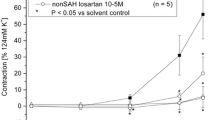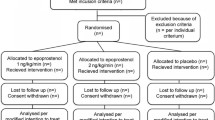Summary
Thromboxane, a highly vasoactive substance, is found in the cerebrospinal fluid of patients and experimental animals following subarachnoid haemorrhage. A stable synthetic analogue of thromboxane A2 was administered intracisternally in rabbits. This resulted in an increase in endothelial permeability of the major cerebral arteries to Evans Blue dye and horseradish peroxidase. Thromboxane may be involved in the pathogenesis of cerebral vasospasm and may be related to the contrast enhancement of the arteries in the basal cisterns on CT scans of patients who are prone to develop arterial narrowing.
Similar content being viewed by others
References
Alksne JF, Greenhoot JH (1974) Experimental catecholamineinduced cerebral vasospasm: Myonecrosis in vessel wall. J Neurosurg 41: 440–445
Allen GS, Henderson LM, Chou SN, French LA (1974) Cerebral arterial spasm. I.In vitro contractile activity of vasoactive agents on canine basilar and middle cerebral arteries. J Neurosurg 40: 433–441
Allen GS, Gross CJ, French LA, Shelley NC (1976) Cerebral arterial spasm. Part 5.In vitro contractile activity of vasoactive agents including human CSF on human basilar and anterior cerebral arteries. J Neurosurg 44: 594–600
Boullin DJ, Mohan J, Grahame-Smith DG (1976) Evidence for the presence of a vasoactive substance (possibly involved in the aetiology of cerebral arteries spasm) in cerebrospinal fluid from patients with subarachnoid haemorrhage. J Neurol Neurosurg Psychiatry 39: 756–766
Boullin DJ, Brandt T, Ljungren B, Tagari P (1981) Vasoconstrictor activity in cerebrospinal fluid from patients subjected to early surgery for ruptured intracranial aneurysms. J Neurosurg 55: 237–245
Brandt L, Ljungren B, Andersson KE, Hindfelt B, Teasdale G (1981) Vasoconstrictive effects of human post-haemorrhagic cerebrospinal fluid on cat pial arteriolesin situ. J Neurosurg 54: 351–356
Brandt L, Ljungren B, Andersson KE, Hindfelt B, Uski T (1981) Effects of indomethacin and prostacylclin on isolated human pial arteries contracted by CSF from patients with aneurysmal SAH. J Neurosurg 55: 877–883
Dóczi T, Ambrose J, O'Laoire S (1984) Signifiance of contrast enhancement in cranial computerized tomography after subarachnoid hemorrhage. J Neurosurg 60: 335–342
Echlin FA (1968) Current concepts in the etiology and treatment of vasospasm. Clin Neurosurg 15: 133–160
Ellis EF, Nies AS, Oates JA (1977) Cerebral arteries smooth muscle contraction by thromboxane A2. Stroke 8: 480–483
Gavras H, Andrews P, Paradakis N (1981) Reversal of experimental delayed cerebral vasospam by angiotensin-converting enzyme inhibition. J Neurosurg 55: 884–888
Graham R, Karnovsky MJ (1966) The early stages of absorption of injected horseradish peroxidase in the proximal tubules of mouse kidney: Ultrastructural cytochemistry by a new technique. J Histochem Cytochem 14: 291–302
Handa J, Yoneda S, Matsuda M, Handa H (1974) Effects of prostaglandins A1, E1, E2, and 150-01 on the basilar artery of cats. Surg Neurol 2: 251–255
Hirata Y, Matsukado Y, Fukumura A (1982) Subarachnoid enhancement secondary to subarachnoid hemorrhage with special reference to the clinical significance and pathogenesis. Neurosurgery 11: 367–371
Katsura M, Miyamoto T, Hamanaka N, Kondo K, Terada T, Ohgaki Y, Kawasaki A, Tsuboshima M (1983)In vitro andin vivo effects of new powerful thromboxane antagonists (3-alkylamino pinane derivatives). In: Samuelsson B, Paoletti R, Ramwell P (eds) Advances in prostaglandin, thromboxane, and leukotriene research, vol 11. Raven Press, New York, pp 351–357
Kawahara Y, Yamanishi J, Furuta Y, Kaibuchi K, Takai Y, Fukuzaki H (1983) Elevation of cytoplasmic free calcium concentration by stable thromboxane A2 analogue in human platelets. Biochem Biophys Res Commun 117: 663–669
Kurozumi T (1975) Electron microscopic study on permeability of the aorta and basilar artery of the rabbit with special reference to the changes of permeability by hypercholesteremia. Exp Mol Pathol 23: 1–11
Nagy Z, Mathieson G, Hüttner J (1979) Blood-brain barrier opening to horseradish peroxidase in acute arterial hypertension. Acta Neuropathol 48: 45–53
Okwuasaba FK, Weir BKA, Cook DA, Krueger CA (1981) Effects of various intracranial fluids on smooth muscle. Neurosurgery 9: 420–406
Osaka K (1977) Prolonged vasospasm produced by the breakdown products of erythrocytes. J Neurosurg 47: 403–411
Palade GE (1960) Transport in quanta across the endothelium of blood capillaries. Anat Rec 136: 254
Pickard JD, Vinall PE, Simeone FA (1975) Prostaglandins and cerebral vasospasm: A problem of interpretation. Surg Forum 26: 496–498
Rosenblum WI (1975) Effects of prostaglandins on cerebral blood vessels: Interaction with vasoactive amines. Neurology 25: 1169–1171
Sasaki T, Tamishima T, Asano T, Mayanagi Y, Sano K (1979) Significance of lipid peroxidation in the genesis of chronic vasospasm following rupture of an intracranial aneurysm. Acta Neurochir (Wien) [Suppl] 28: 536–540
Sasaki T, Wakai S, Asano T, Takakura K, Sano K (1982) Prevention of cerebral vasospasm after SAH with a thromboxane synthetase inhibitor, OKY-1581. J Neurosurg 57: 74–82
Sasaki T, Asano T, Takakura K, Sano K, Kassell NF (1984) Nature of the vasoactive substance in CSF from patients with subarachnoid hemorrhage. J Neurosurg 60: 1186–1191
Sasaki T, Kassell NF, Yamashita M, Fujiwara S, Zuccarello M (1985) Barrier disruption in the major cerebral arteries following experimental subarachnoid hemorrhage. J Neurosurg 6: 433–440
Sobel D, Li FC, Norman D, Newton TH (1981) Cisternal enhancement after subarachnoid hemorrhage. AJNR 2: 549–552
Spurr AR (1969) A low viscosity epoxy resin embedding medium for electron microscopy. J Ultrastruct Res 26: 31–43
Tanabe Y, Sakata K, Yamada H, Ito T, Takada M (1978) Cerebral vasospasm and ultrastructural changes in cerebral arterial wall: An experimental study. J Neurosurg 49: 229–238
Tani E, Yamagata S, Ito Y (1978) Intercellular granules and vesicles in prolonged cerebral vasospasm. J Neurosurg 48: 179–189
Tazawa T, Mizukami M, Kawase T, Usami T, Togashi O, Hyodo A, Eguchi T (1983) Relationship between contast enhancement on computed tomography and cerebral vasospasm in patients with subarachnoid hemorrhage. Neurosurgery 12: 643–648
Walker V, Pickard JD, Smythe P, Eastwood S, Perry S (1983) Effects of subarachnoid hemorrhage on intracranial prostaglandis. J Neurol Neurosurg Psychiatry 46: 119–125
Westergaard E, Go G, Klatzo I, Spatz M (1976) Increased permeability of cerebral vessels to horseradish peroxidase induced by ischemia in Mongolian gerbils. Acta Neuropath 35: 307–325
White RP, Hagen AA, Morgan H, Dawson WN, Robertson JT (1975) Experimental study on the genesis of cerebral vasospasm. Stroke 6: 52–57
Author information
Authors and Affiliations
Rights and permissions
About this article
Cite this article
Zuccarello, M., Sasaki, T., Kassell, N.F. et al. Effect of intracisternal thromboxane A2 analogue on cerebral artery permeability. Acta neurochir 90, 144–151 (1988). https://doi.org/10.1007/BF01560570
Issue Date:
DOI: https://doi.org/10.1007/BF01560570




